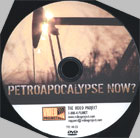
Petroapocalypse Now? 2008
Distributed by The Video Project, PO Box 411376, San Francisco, CA 94141-1376; 800-475-2638
Produced by Andrew Evans
Directed by Andrew Evans
DVD, color, 47 min.
Sr. High - Adult
Business, Economics
Date Entered: 02/05/2010
Reviewed by Michael Coffta, Business Reference Librarian, Bloomsburg University of PennsylvaniaCan the petroleum supply continue to power the over 700 million vehicles on the planet? Can we sustain our civilization without the cheap energy that made its growth and modernization possible? This superbly crafted film states that the demand for petroleum is nearing surpassing the world’s rate of extraction. Petroapocalypse Now? not only questions the accuracy of estimates of the remaining quantity of oil, but the capacity at which oil producing nations can extract it. In no uncertain terms, the film makers present data illustrating the increasing use of fossil fuels exceeding discoveries of new oil sources and the ability to reach them. A single, telling graph demonstrates the decline in new oil source discovery since 1985. Furthermore, China’s economic boom has accelerated this approaching deadline of “peak oil,” or the point at which demand surpasses the ability to sustain supply. It discusses petroleum companies’ possible cover ups and smearing of numbers regarding oil reserves, and peak oil forecasts by OPEC.
There is no misunderstanding the doomsday outlook of this film, given its title. The film makers unequivocally predict a “day of reckoning” scenario of total, sudden production collapse. As an alternate scenario, they comment on the maladies of a protracted decline, should that become the case. Dotted with commercials and news clips from 1960 to the present, the audience is given evidence of the U.S.’s (and the world’s) disregard for warning signs, and continuing its reliance on a finite energy resource. There is a jarring segment taken from an address by Jimmy Carter during his presidency, repeating the warnings, nearly word for word, that are becoming manifest today.
A rapid drumbeat in the background of the majority of this film gives it a nervous, newscast expose feel. With an openly subjective style, this film scathingly probes how petroleum companies and petroleum producing countries are proliferating their model. That said, the data and statistics offered are well researched and presented in a compelling manner. This film is highly recommended to anyone interested in petroleum production and consumption.